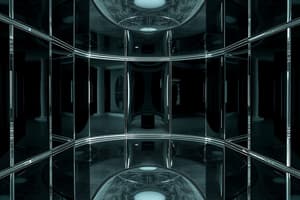Podcast
Questions and Answers
What transformation can be used to show that two figures are congruent?
What transformation can be used to show that two figures are congruent?
- Stretching
- Skewing
- Dilation
- Rotation (correct)
Which type of angle relationship can be established when parallel lines are cut by a transversal?
Which type of angle relationship can be established when parallel lines are cut by a transversal?
- Alternate interior angles (correct)
- Adjacent angles
- Vertical angles
- Complementary angles
How can you find the slope of a line using similar triangles?
How can you find the slope of a line using similar triangles?
- The area of the triangle
- The ratio of the vertical change to the horizontal change (correct)
- The angle of elevation
- The length of the hypotenuse
What sequence of transformations results in two figures being similar?
What sequence of transformations results in two figures being similar?
What is the formula for the volume of a cylinder?
What is the formula for the volume of a cylinder?
In what context are informal arguments used in relation to angles?
In what context are informal arguments used in relation to angles?
Which of the following transformations does NOT preserve congruence?
Which of the following transformations does NOT preserve congruence?
What is the relationship between the slopes of two distinct points on a non-vertical line?
What is the relationship between the slopes of two distinct points on a non-vertical line?
What effect does a dilation have on a figure?
What effect does a dilation have on a figure?
Flashcards are hidden until you start studying
Study Notes
Congruent and Similar Figures
- Congruent figures can be transformed into each other through a sequence of rotations, reflections, and translations.
- Similar figures are obtained by applying transformations, including rotations, reflections, translations, and dilations.
- Transformations may change size, but similar figures maintain proportional relationships between corresponding angles and sides.
Transformations
- Rotations: Turning a figure around a fixed point.
- Reflections: Flipping a figure over a line to create a mirror image.
- Translations: Shifting a figure in a specific direction without changing its shape or size.
- Dilations: Resizing a figure while maintaining the shape and proportionality of dimensions.
Angles in Triangles and Transversals
- Informal reasoning can establish facts regarding angles created by transversals intersecting parallel lines, such as alternate interior angles being congruent.
- The interior angles of a triangle sum to 180 degrees.
Slope and Similar Triangles
- The slope (m) between two distinct points on a non-vertical line is consistent, showcasing the properties of similar triangles.
- Similar triangles maintain proportional relationships, providing a basis for understanding slopes in the coordinate plane.
Volume Formulas
- Volume formulas are critical for solving real-world problems involving geometric shapes:
- Cone: ( V = \frac{1}{3} \pi r^2 h )
- Cylinder: ( V = \pi r^2 h )
- Sphere: ( V = \frac{4}{3} \pi r^3 )
Problem Solving
- Apply knowledge of transformations and volume formulas to address practical mathematical scenarios.
- Utilize properties of congruence and similarity to analyze two-dimensional figures and solve relevant problems.
Studying That Suits You
Use AI to generate personalized quizzes and flashcards to suit your learning preferences.




